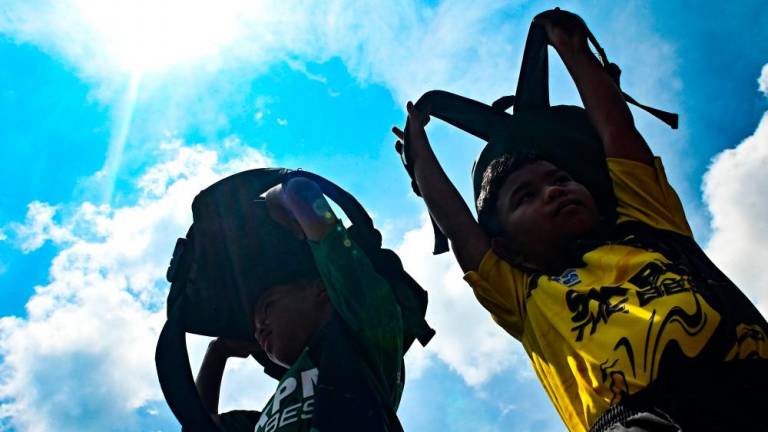WITH jobs going bust and airline pilots turning into e-hailing drivers, the last thing you want to hear is your boss telling you that he can’t figure out what role you play in the office. If he is certain you have no role, you will be shown the exit.
All 7.8 billion people in the world are now in a situation where the boss may soon tell them that they are not of any use, and so please step out of planet Earth or get snuffed out. Not only are we of no use, we terrorise every other worker in the office. That’s to say, we are destroying non-human life.
Mother Nature is a stern boss and every species has its work cut out. The insects that crawl or buzz everywhere decompose dead plants, carrion, and dung into nutrients for use by the ecosystem. They pollinate flowering plant species and crop plants, help dry soil retain water, and themselves become food for birds.
Without insects, 90% of plants cannot reproduce. There are five million insect species, but a million are going extinct and the reason is obvious to insect experts. Swelling human populations lead to more forest loss, greater pesticide use, widespread pollution, and plantation monoculture – all detrimental to wild insect life.
Butterflies used to be a common sight in Malaysian gardens after rain. These days, you hardly see them any more except in butterfly parks. With fewer insects, there will be fewer birds, fewer trees, and less fertile soil for crops. Insects are the foundation of every natural ecosystem. National Geographic in its May 2020 issue carried this grim quotation: “Plants and insects are the fabric of this planet. We’re ripping it to shreds, and we need to knit it back together.”
Name one species of plant or animal – other than humans – that doesn’t play a role in the natural ecosystem.
Even the nasty mosquito does some good for others. The larvae of pond mosquitoes play an important role in the aquatic food chain as they are, in essence, nutrient-packed snacks for fish and other aquatic animals. Mosquito larvae feed on the waste products of drowned insects, making nutrients such as nitrogen available for the plant community to thrive. As adults, mosquitoes become nutritious meals for birds, bats, and spiders.
During the hunter-gatherer era that lasted 300,000 years, primitive humanity did fit into the natural ecosystem as they took only what they needed from the forest – much like a shopper in a hypermarket who takes from the shelves only what he is able to carry in his hands.
But humans started to change some 10,000 years ago when tribes merged and settlements grew into cities that became the starting points of civilisation 5,000 years later. By 4000 BCE, one giant-sized animal – the mammoth – had become extinct because of human encroachment. It was just the beginning of civilised humanity’s unrelenting war of terror against nature.
Before the advent of civilisation, only one species in a million would go extinct every five million years. But the rate of extinction is now 1,000 times the natural baseline rate due to the push from human overpopulation, continued population growth, and high consumption. It will keep accelerating unless there are cutbacks on population growth and consumption.
At the height of the Covid-19 lockdown, there were tales across the globe of wild animals roaming places deserted by humans. These spots were once their habitats converted into urban spaces.
In Malaysian cities, monkeys were chilling out in some condo swimming pools. If you check the history of these condos, you will find that they were built on flattened monkey hills.
A black panther was spotted at the Universiti Teknologi Mara Kuala Pilah campus, once a patch of dense forest that serve as home to panthers, leopards, tapirs and sun bears.
Human survival is of no benefit to nature, as we have caused wildlife to go into catastrophic decline. To avoid being shown the exit, our irreverent treatment of nature must be replaced with a sense of reverence.
You may be playing a role in society, but what role are you playing in nature? What role is your ethnic or religious community playing in nature? When was the last time your preacher rallied the congregation against the destruction of wildlife habitats? When was the last time your community joined a save-the-environment drive that featured all the major religions in Malaysia working together?
We need a conversion back to the primeval spirituality of the orang asli and orang asal in their ancient hunter-gatherer mode. These folks see divinity in the myriad forms of nature. Call it natural revelation. While it may be said that their faith is simple, their belief in nature ensures a harmonious existence between the tribes and the forest habitats teeming with animals.
Thankfully, some property developers have initiated a return to nature by converting old mining land into parks that become sanctuaries for birds and small animals.
But more needs to be done.
Do you want your grandchildren to be shown the exit 80 years from today?
The writer champions interfaith harmony. Comments: letters@thesundaily.com














